Stefan Peiß, the member of KfW’s Executive Board responsible for risk management, and former stunt woman Miriam Höller discuss risk at work and in life – as well as climate risks, the new challenge in the field of risk management.
Dr Stefan Peiß
Risks have been his subject since completing his doctorate: Stefan Peiß was responsible for risk controlling at Bayerische Landesbank before joining KfW in 2009. He has been KfW's Chief Risk Officer since 2016.
Miriam, Stefan, you just went abseiling and ran 100 metres down the side of a skyscraper in Frankfurt, from the roof to the ground. What was that like?
STEFAN PEISS: Quite exhilarating. Especially the moment I went over the edge and tipped into the horizontal plane from the vertical one, gazing downwards. That is a special moment. Once you’re hanging onto the wall, it’s fine. It’s basically an opportunity to experience risk management first hand, because everything is organised to be safe. I felt good about it.
MIRIAM HÖLLER: It brought me back to my old world. It was great to feel the adrenaline again. My whole body is tingling, and now I’m truly awake!
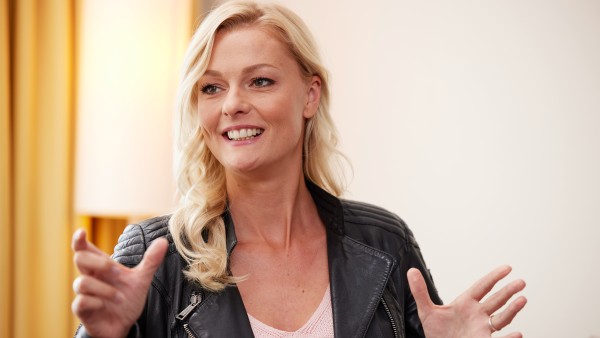
Miriam Höller
Germany's best-known stuntwoman had to end her stunt career in 2016 after an accident. Today she works as a presenter and speaker for companies.
Miriam, you worked as a stunt woman for ten years. What drew you to that line of work?
HÖLLER: When I was a child, I dreamed of being able to fly and having superpowers. When I was older, I initially began classic ballet training. But it quickly became apparent that I would grow too tall for ballet. When I was 15, I saw a stunt show at Movie Park Germany. It captivated me so much that I applied to work there. That was exactly what I wanted to do! My parents supported my decision – but first I had to wait until I turned 18. Then I was in my element.
Stefan, when did you know that you were in your element?
PEISS: I began with an apprenticeship at a bank when I was 20 years old. My goal after was to work in customer relations. But first I studied business administration in Munich. My doctoral thesis was about risks in real estate finance and led me back to the bank. A new unit had just been created at Bayerische Landesbank, where they were trying out many new things and did practically orientated work. That was where I became familiar with the multitude of bank risks; from that point on, risk was my focus. In 2009, I began my work as senior vice president, head of risk management and controlling at KfW. Later on, KfW decided to submit to financial oversight, like a normal commercial bank. Once this was implemented in 2016, I was appointed to the Executive Board.
Why are you so fascinated by the subject of risk?
PEISS: It is complex and never monotonous. As a bank, we need to deal with many different risks: credit risks, market risks that include changes to interest and exchange rates, as well as operational risks. Add to that liquidity risks and risks to reputation, or even general business risks like the ones that arise from changing economic conditions, for example. To clear up a commonly held misconception, risk management does not mean avoiding risks – it means making them manageable. To do that we need to know what they are and quantify them.
HÖLLER: That is very similar to stunt work. The main difference is that, for stunt people, the risks are always to our health or even our lives. I can only minimise these risks if know myself well and know that I can rely on my team. Calculating risk begins with the questions, “How am I feeling physically and mentally? What am I really able to achieve right now?” Stunt work is 95 per cent preparation. The remaining risk is quite minimal.
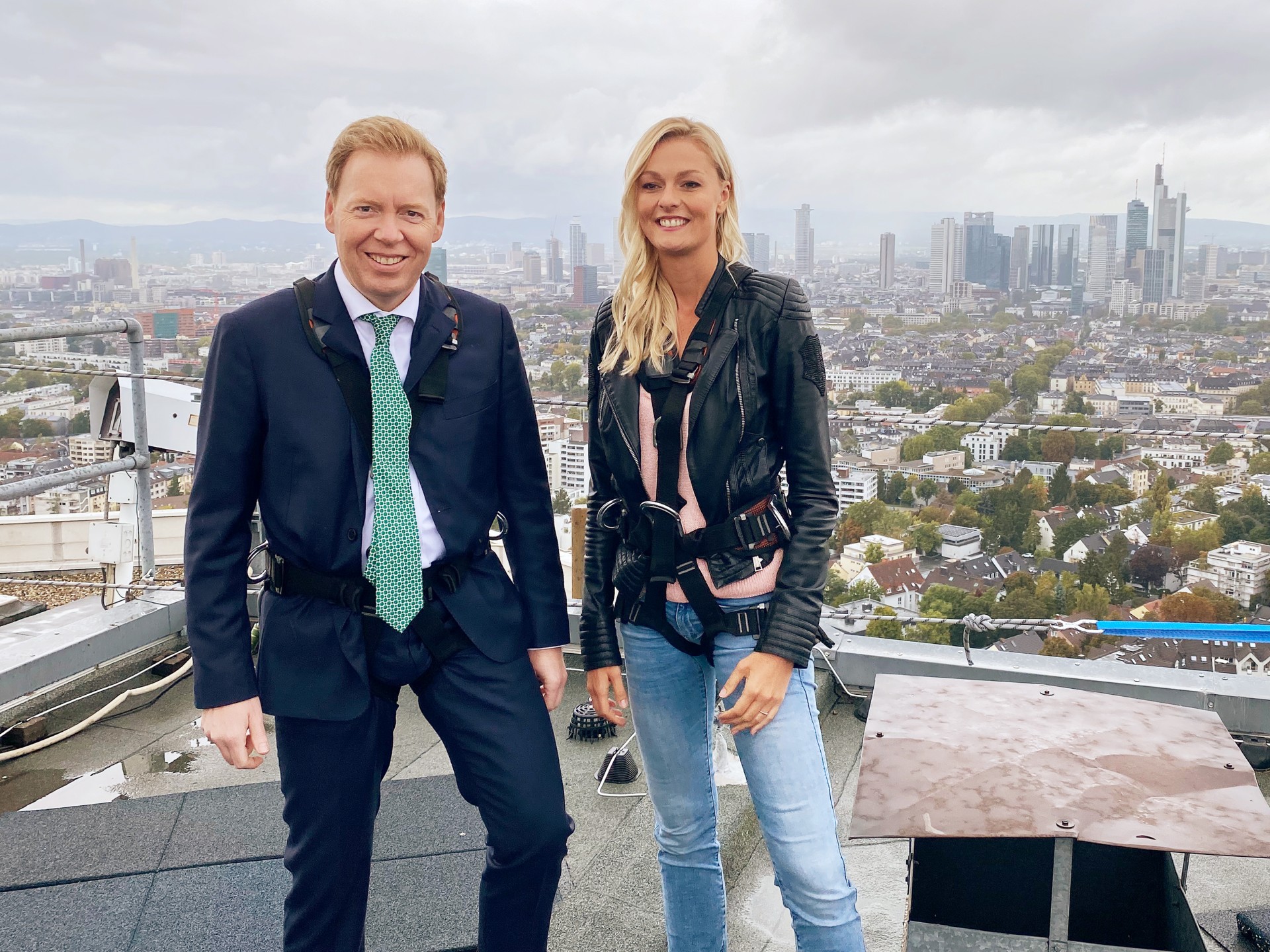
Frankfurt skyline
Miriam Höller and Stefan Peiß shortly before the downhill run on the roof of the Leonardo Hotel in Frankfurt Sachsenhausen. The safety harness is already on.
What is the most dangerous thing you’ve done?
HÖLLER: Risk is relative. I created flaming wings that I can wear on my shoulders – a wing-shaped steel frame that weighs about 25 kilograms with a wingspan of three metres. The steel frame is wrapped in fabric that is soaked in a flammable liquid. It’s an impressive stunt that I can easily control. During one stunt show, I was supposed to walk down an outdoor runway in front of a large audience while wearing the flaming wings. That was one of my most difficult stunts because I had to take factors like the wind into account. The wind would repeatedly twist the wings around their axis and the flames would be buffeted around unpredictably.
Stefan, the topic of wind is a good segue. This past summer we experienced many seemingly uncontrollable extreme weather events: the disastrous flooding in Germany, the forest fires in Turkey, the extreme heatwave in Canada. What role do climate risks play for banks?
PEISS: Climate risks can be divided into physical risks and transition risks. Transition risks are regulatory interventions made by the government. One example of this would be if they were to raise a carbon tax. Storm-driven flooding is among the physical risks, as we recently saw. As the risks directly affect businesses’ creditworthiness, there are also associated risks for the banks, which have to quantify and manage these risks.
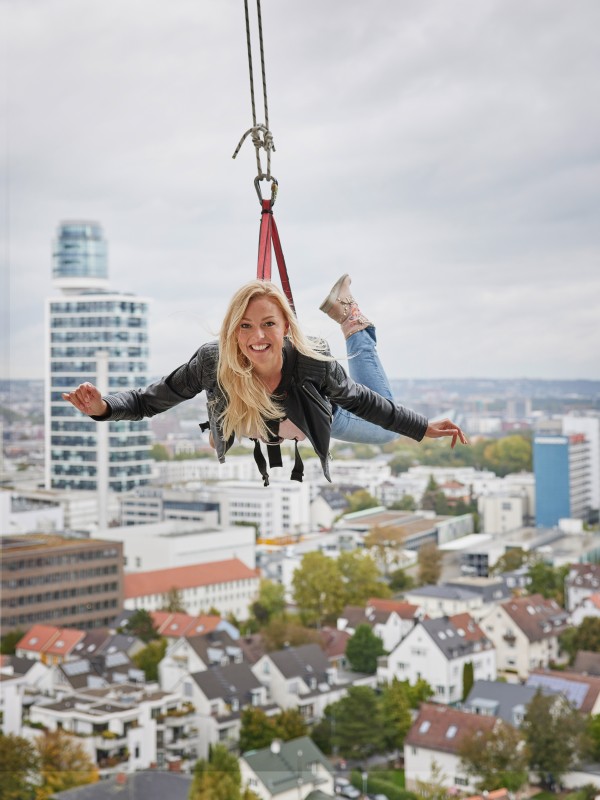
High above Frankfurt
Miriam Höller flies, held only by her safety harness, in front of the hotel with the new 'Henninger Tower' in the background.
Could you use an example to illustrate how this works in practice?
PEISS: When we grant loans, we also evaluate the individual business models to examine how susceptible they are to climate risks. When we finance a construction project on the coast, we need to take into account that the borrower may not be able to pay the loan back if the sea level rises and makes the property unusable. Or we might have to consider that a steel producer needing huge amounts of power may no longer be profitable if they need to pay much more for electricity due to carbon pricing. We incorporate these effects into a business analysis during the loan granting process. We do this with a broad scope, in our ranking systems, loan granting processes, limit systems. Our task is to make it possible to calculate climate risk, something which is currently still a tremendous challenge.
Why is that?
PEISS: There are so many unknown factors, so we have to work with hypotheticals. First of all, we don’t know exactly how much the Earth’s temperature is going to rise. Secondly, we are dealing with quite a long timescale; risk management systems typically take into account risks that could become reality within one to two years. In the context of climate risks, we have to think on a timescale of 20 or 30 years. And then, as Miriam put it, we need to expect the unexpected, like extreme weather events.
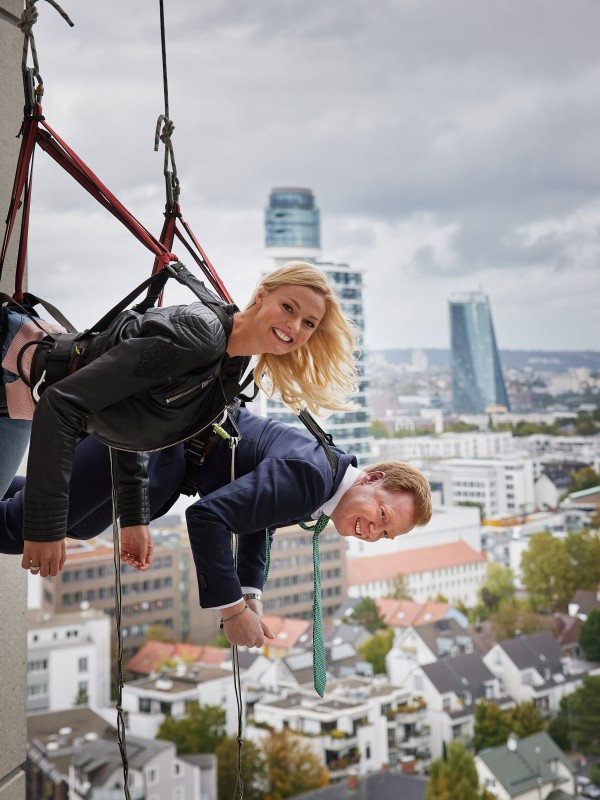
Downwards
Miriam Höller and Stefan Peiß shortly after the start of the house-running. The adrenalin is flowing. Now it's a steep 100-metre descent. In the background the new 'Henninger Tower' and the ECB headquarters (right).
The unexpected happened to your career in 2016, Miriam.
HÖLLER: ... Yes, that’s true. I was working on a photo shoot for a fashion magazine where I had to hang from a helicopter, and the photo was taken as I jumped down. I was going through a difficult time in my personal life at that point, which affected me mentally and physically. Regardless, I was convinced that I would be able to handle the job because of the experience that comes from routine. The customer didn’t think the images were spectacular enough, so I pushed myself past my limits. That was a massive mistake. I crashed during a jump and broke both feet in the process – I even shattered my left foot.
Since your accident, you have no longer been able to practice your profession. For a while it even looked like you may never walk again. Then your partner, Austrian aerobatics champion Hannes Arch, was in a fatal accident. How did you manage to put your life back together after these tragic blows? Why?
HÖLLER: It all happened within six weeks. I sat in a wheelchair; my partner had died. I moved back to Germany from Austria, having lost everything I had worked so hard for and that had made me who I was. We like to define ourselves through our professions or through other people. But now I was forced to face the essential question of who I am when the entire world comes crashing down around me. Today, I’m convinced that it’s possible to overcome any crisis when you find the answer to this question. But it took me a great deal of time. I had to painstakingly remember the Miriam at my core – the brave, determined and curious girl from the countryside – once I reached that point, I began to reinvent myself.
Today you stand on stages and encourage others as a sort of resilience coach.
HÖLLER: I view myself as more of an adventurer who is truly experiencing life, who has come a bit closer to her truth, her values and her personality through those adventures. We ourselves are responsible for attributing the meaning we give to crises and changes. I needed professional help after my accident. In a self-help group for young women who had lost their husbands, I noticed two women. One of them sat with her baby in her arms and said, “Today will be the last time I come here. I found someone new and had a child. Life goes on.” And the other woman berated her terribly because she had stabbed her deceased partner in the back. That’s when I told myself: “Miriam, in five years you can be this woman or the other one.” I wanted to be the one with the positive attitude towards life.
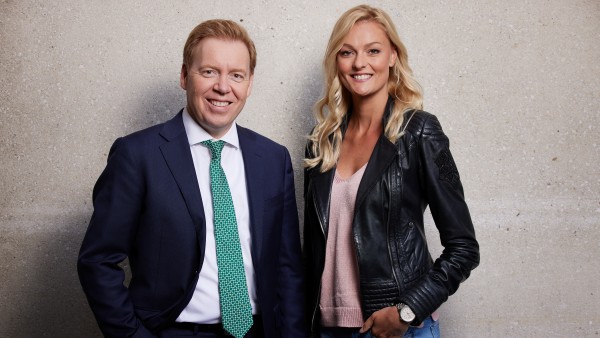
Summit
KfW Risk Director Stefan Peiß and former stuntwoman Miriam Höller first walked down a high-rise wall together. Then they debated risks in work and in life.
How did you become a speaker?
HÖLLER: At one point, I received a request from a company that had come to a critical point in its development. I simply told my life story there. And I closed my presentation by saying, “Life poses so many questions. Now I’m on my way to finding answers. But maybe that is our purpose.” Today, my talks are more deliberate and have clearer messages. But my motivation is still the same. If there is even one person in the audience I can encourage to persevere and convince them to use challenges as an opportunity for themselves, then I’ve achieved my goal.
Stefan, KfW also deals with the subject of resilience, financing activities that include projects to increase what is known as climate resilience.
PEISS: Climate change is under way. We can’t deny it. So it is vital that we build climate resilience – our ability to quickly recover and indeed prevent the adverse effects of climate change. Around half of our financing efforts around the world are climate-related. We help companies, institutions and individuals to invest in renewables and sustainable transport, make changes to production processes, and insulate buildings to save energy and reduce carbon emissions. We also promote specific measures that protect against flooding both in Germany and in Financial Cooperation partner countries. Ultimately, we support a number of innovative insurance instruments that increase climate resilience, such as insurance against drought-induced damage in Africa.
What makes you optimistic that KfW will be able to deal with climate risks?
PEISS: Miriam talked about her values. I’d like to continue on that point. We are a climate bank and, as such, we are intrinsically motivated to address climate risks. For instance, we were one of the first financial institutions to sign the United Nations’ Principles for Responsible Investments in 2006. The issue really began gaining momentum within KfW in 2017. We gradually became a sustainability bank. Then in 2020, KfW was already able to implement the first climate risk stress test as a result of that process, in turn pioneering this work. But a lot has also happened on the market side. So, for example, we are the first bank to align our entire portfolio with the UN’s Sustainable Development Goals. We are gradually expanding how we take climate risks into account both on the market side as well as in our risk management activities.
Miriam, are there any words of wisdom you would like to give us as we part ways?
HÖLLER: I think the most important question to ask ourselves about climate change – and generally about life, by the way – is “what have we not done, what will we come to regret?” I am convinced that it is better to actively try things, to fail and learn from that failure, than to simply wait and see. Because we have done that long enough. We need more pioneers with clear strategies – and collaborative thinking and action to usher in positive change and a bright future.
Published on KfW Stories on: 3 December 2021

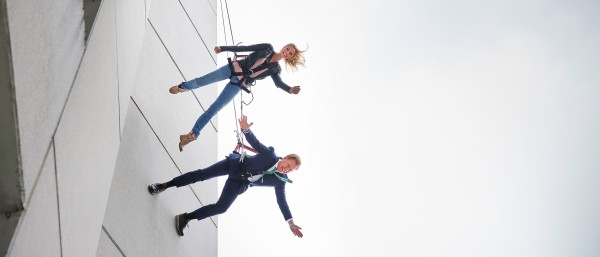
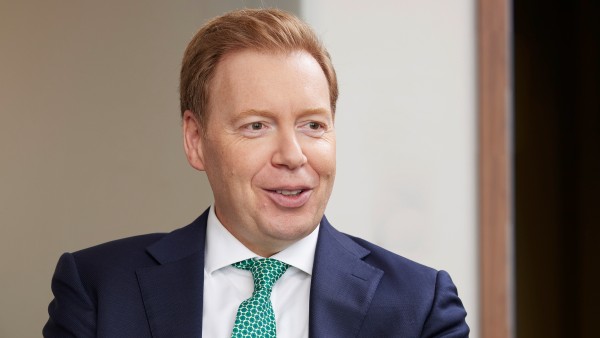
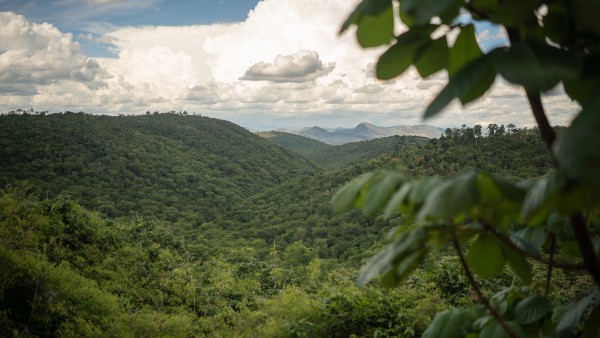
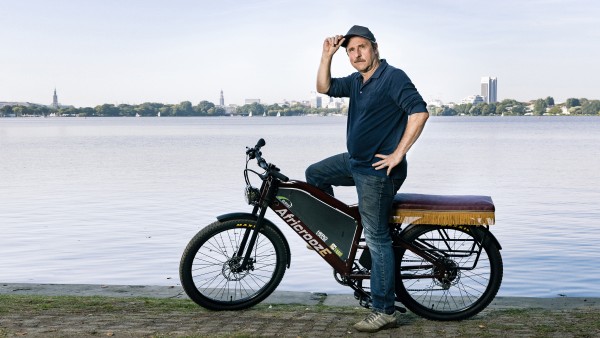

Data protection principles
If you click on one of the following icons, your data will be sent to the corresponding social network.
Privacy information